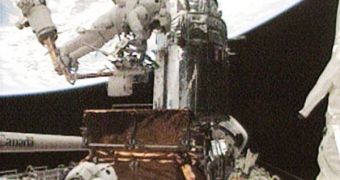Astronauts Michael Massimino and Michael Good conducted the fourth out of five spacewalks of the STS-125 mission to the Hubble Space Telescope on Sunday, and successfully managed to repair the observatory's Space Telescope Imaging Spectrograph (STIS) instrument. Installed in 1997, it failed in 2004, and was never designed to be repaired in orbit, NASA's Mission Control in Houston said. However, the two astronauts succeeded in doing that in an Extra-Vehicular Activity (EVA) that lasted more than eight straight hours. Still, despite being on their mission schedule, they did not have enough time to install a new insulating layer on Hubble.
The imaging spectrograph is a very important and unique instrument on Hubble, because it can also act like a camera for the 19-year-old observatory. Its basic operating principle is fairly simple – it breaks down light into its composing wavelengths, and can thus detect supermassive black holes in the distant Universe, and can also analyze the atmosphere around distant exoplanets. During the repairs, the instrument initially powered on in a test, but soon broke down again, due to temperature variations.
Additionally, the STIS was held in place with 111 small screws, and with a handrail as well. It took about two hours for the astronauts to remove the handrail, because their powered screwdrivers kept failing to move a jammed bolt. In the end, they had to remove the rail by brute force, which required additional time for preparations. Massimino and Good had to cover everything with duct tape, in order to ensure that no components would come flying off when they ripped the handrail. The spacewalk lasted for more than eight hours, which made it the sixth longest in history. It began at 9:45 am EDT (1345 GMT).
“It's a real privilege to see what we've seen and to work on this magnificent machine. I couldn't be any more grateful for the opportunity,” Massimino said after the job was done. “The science capabilities that we've been given today are fabulous. Now we're going to start contemplating what kinds of things we can do with them,” Goddard Space Flight Center Chief of Exoplanet Research and Stellar Astrophysics Jennifer Wiseman added. “Congratulations, you brought STIS back to life,” Atlantis Astronaut John Grunsfeld told the two spacewalkers, Space reports.
The fifth and last spacewalk of the STS-125 mission is scheduled to take place on Monday, and the people at NASA hope that they will be able to squeeze the repairs to the insulating layer in on it too. It will be the last human intervention to the Hubble, which will, due to the latest efforts, remain active until at least 2014. Hopefully, by that time, its replacement, the James Webb Space Telescope, will have already become operational.

 14 DAY TRIAL //
14 DAY TRIAL //